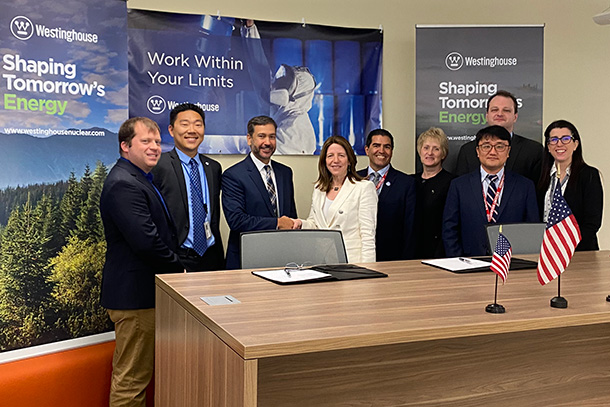Concept art of the planned Gadsden, Ala., MMR assembly plant. (Image: Ultra Safe Nuclear)
Ultra Safe Nuclear (USNC) announced on June 21 that it has selected the city of Gadsden, Ala., to host a $232 million MMR assembly plant. Modules for the company’s high-temperature, gas-cooled and TRISO-fueled microreactor, dubbed the Micro-Modular Reactor (MMR), would be manufactured, assembled, and tested at the “highly automated facility” once it is in operation.
INL prepares to ship PCAT by truck to Pennsylvania for testing. (Photo: INL)
An electric-powered prototype of MARVEL, the tiny microreactor designed and planned for operation inside the Transient Reactor Test (TREAT) facility at Idaho National Laboratory, has successfully been installed at a manufacturing facility in Pennsylvania ahead of a testing program that could begin as early as July, the Department of Energy announced on May 22.
A rendering of Oklo’s Aurora Powerhouse. (Image: Oklo)
Santa Clara, Calif.–based Oklo is planning to build its second and third commercial Aurora Powerhouse nuclear plants in southern Ohio, the company announced yesterday. The advanced reactor developer received a site permit in December 2019 from the Department of Energy to build its initial Aurora facility at Idaho National Laboratory.
According to the announcement, Oklo has signed an agreement with the Southern Ohio Diversification Initiative (SODI), a community-reuse organization, to deploy two 15-MWe plants on land owned by SODI at the Portsmouth site near Piketon, Ohio. The DOE began transferring parcels of the Portsmouth site—home to the Portsmouth Gaseous Diffusion Plant, now undergoing decontamination and decommissioning—to SODI in June 2018 for economic development.
Local officials, industry representatives, and others joined leaders from AECL, CNL, and GFP to mark the site of Canada’s first microreactor. (Photo: AECL)
A rendering of Last Energy's nuclear power plant. (Image: Last Energy)
Startup company Last Energy has announced power purchase agreements for 34 units of its 20-MWe nuclear power plants with four industrial partners in Poland and the United Kingdom. In total, according to the company, the deals represent more than $18.9 billion in electricity sales.
A rendering of an eVinci microreactor facility. (Image: Westinghouse)
Westinghouse Electric Company has filed a notice of intent to submit key licensing reports for its eVinci microreactor to the Nuclear Regulatory Commission and Canadian Nuclear Safety Commission for joint review, the firm announced last week. (The two nuclear regulators signed a memorandum of cooperation in August 2019 to increase collaboration on the technical reviews of advanced reactor and small modular reactor technologies.)
Industry professionals visit INL as part of a U.S. Nuclear Industry Council Conference. (Photo: INL)
The Department of Energy’s commitment to breaking down market barriers with initiatives, programs, and access to facilities is making it simpler and more efficient than ever for industry to partner with national laboratories. It is especially timely, as the country continues to face evolving security, economic, and clean energy challenges. Partnering opportunities via the DOE’s Cooperative Research and Development Agreements (CRADAs) and Strategic Partnership Projects (SPPs) are particularly prevalent in the commercial nuclear community and have seen a tremendous amount of funding and support dedicated to advancing the development, demonstration, and deployment of new reactor technologies.
Graphic rendition of the Aurora microreactor. (Image: Oklo Inc.)
Some eight months after the Nuclear Regulatory Commission denied Oklo Inc.’s license application to build and operate its Aurora microreactor in Idaho, the company has returned to the regulatory fray. On Wednesday, Oklo announced that it has submitted to the NRC a licensing project plan (LPP) outlining its proposed engagement to support future Aurora licensing activities.
A screenshot taken from a INL video demonstrating MAGNET and its digital twin. (Source: INL)
Researchers at Idaho National Laboratory (INL) recently performed their first digital twin test of the Microreactor Agile Non-nuclear Experimental Testbed (MAGNET) and captured the demonstration in a video posted July 14. The digital twin—a virtual representation of a microreactor—was built using advancements in remote monitoring, autonomous control, and predictive capabilities that could help lower operating costs of microreactor technologies and enhance their safety.
Artist’s rendering of BWXT’s Project Pele transportable reactor modules arriving for set up and operation. (Image: BWXT)
BWX Technologies, Inc., will deliver the first microreactor in the United States under a contract awarded by the U.S. Department of Defense Strategic Capabilities Office (SCO), the company announced today. BWXT will have two years to build a transportable microreactor prototype to the SCO’s Project Pele specifications and deliver it to Idaho National Laboratory for testing under a cost-type contract valued at about $300 million.
McMaster University, in Hamilton, Ontario, Canada. (Photo: McMaster University)
McMaster University, Ultra Safe Nuclear Corporation (USNC), and Global First Power (GFP) have embarked on a new partnership to study the feasibility of deploying a USNC Micro Modular Reactor (MMR) at McMaster University or an affiliated site. The three partners last week announced a memorandum of understanding that will support research on advanced reactor and small modular reactor technologies in support of Canada’s Net-Zero Emissions by 2050 goal.

Representatives from Westinghouse and Penn State met at Westinghouse headquarters to sign a memorandum of understanding and enter a partnership focused on researching and developing microreactors. From left: Jason Beebe, director of the global transformation office at Westinghouse; Michael Valore, senior director of advance reactor commercialization, Westinghouse; Mike Shaqqo, senior vice president of advanced reactors, Westinghouse; Lora Weiss, senior vice president for research at Penn State; Jean Paul Allain, head of the Ken and Mary Alice Lindquist Department of Nuclear Engineering at Penn State; Geanie Umberger, associate vice president for research and director of industry research collaborations at Penn State; Saya Lee, assistant professor of nuclear engineering; Elia Merzari (back), associate professor of nuclear engineering; and Hilary Ruby, director of transformation for the Americas Operating Plant Services Business Unit at Westinghouse. (Photo: Westinghouse)
Rory O’Sullivan, Moltex Energy’s chief executive officer, North America, speaks at the SNC-Lavalin/Moltex partnership announcement ceremony at CNA2022.
SNC-Lavalin and Moltex Energy are partnering to advance the development and deployment of small modular reactor technology in Canada, the companies announced last week at the Canadian Nuclear Association’s 2022 conference in Ottawa, Ontario. The partnership will support Moltex as it pursues the licensing and construction of its 300-MW Stable Salt Reactor–Wasteburner (SSR-W), a molten salt reactor that uses nuclear waste as fuel.


















